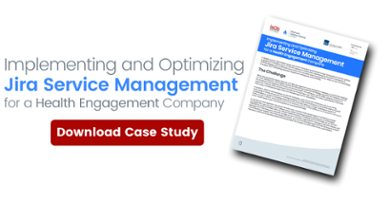Guest Contributor: Mary Ramirez
 An organization's overarching culture and values trickle down to the IT team, both of which drive the way work is done in the department. And it's no secret that the work an IT team does has a major impact on overall business performance, employee productivity, and—if there the team utilizes an external-facing service desk—customer experience and satisfaction.
An organization's overarching culture and values trickle down to the IT team, both of which drive the way work is done in the department. And it's no secret that the work an IT team does has a major impact on overall business performance, employee productivity, and—if there the team utilizes an external-facing service desk—customer experience and satisfaction.
As an Atlassian Platinum Solution Partner, Isos Technology has done our fair share of Jira Service Management (JSM) implementations over the past several years, for a variety of clients in a variety of industries. Based on our vast experience with IT teams of all shapes and sizes, here are a few things we think IT teams should keep top of mind when they set up a service desk within their organization (bear in mind that JSM can help teams achieve all of these objectives).
1. Don’t "F" the Customer!
The KISS Principle (Keep it Simple, Sunshine)
This is actually one of Atlassian’s values, believe it or not. Regardless of whether service desk users are external (customers) or internal (employees), keep the portal simple and don’t place the burden on the end user. We all hate complicated, convoluted applications, so don’t let that be the customer's experience when they use a JSM portal you set up.
Leverage Automation for Jira rules to make SLAs visible
Ensure that end users know what they can expect when they submit a ticket. What are the next steps? Is there additional information required? When can they expect a response?
Make SLAs visible by using Automation for Jira. Service desk customers generally know the IT team is very busy, however, they still need to keep these customers informed as to when they can expect a resolution.
2. Transparency Wins the Day
Document processes...all of them!
Ensure your knowledge base serves as a Google- and YouTube-like resource for the end users. Also—and I can't stress this enough—document ALL of your processes. For instance, end users will need to know what the normal process is for an app request or how email handlers work. If part of the company culture is transparency and visibility, make sure those principles are upheld by instituting a thorough and iterative documentation process.
Set up self-service options
Speaking of documentation, did you know that JSM and Confluence work in conjunction to provide an excellent knowledge base for end users? You can easily decrease the number of tickets that come through by setting up self-service options. For example, if a service desk customer has a question about changing a board administrator, you can leverage Automation for Jira to auto-comment on the issue with a Confluence page explaining how to do so.
3. Tier 1 Triaging is So 1991
Instead of triaging, automate!
Get rid of tier 1 triaging and move into automation. Leverage components for certain request types, or use Automation for Jira for automatic assignments and Time to First Response.
Separate work by team
Set up queues for each team. Separate the work so that agents are only looking at issues that pertain to them.
Automate triggering the on-call team
Incident management no longer requires Tier 1 triaging to see that a service is down. Automatically trigger the on-call team once a specific issue is marked as a level 1 blocker using Opsgenie. Notify the rest of the team using the Slack integration.
Let Culture Lead the Way
Don’t uphold your organization's culture just within the four walls of your company. Let it also guide the way you work with end users and how you set up your organization's ITSM solution. A high-performing IT team is adaptable, proactive, and creative. Leverage JSM to make that impact in your organization today.
Sign up to receive more great content
Learn more about Atlassian and how Isos can help by signing up to receive our latest blogs, eBooks, whitepapers and more.














